
Mazzaella parksii
Iridescent Horn-of-Plenty, Frilly Turf Seaweed
6 June 2023
Mill Bay, Port San Juan, B.C., Canada.
Tide: 0.3 feet at 09:39 PDT (measured at Port Renfrew Tidal Station)
Conditions: Clear, light variable winds, sea smooth to rippled, low to moderate westerly swell, humidity 65%, 14˚C.
Moon: Waning Gibbous (90.5%, 18 days); Previous Phase, Full Moon, 3 June 2023 at 8:41pm PDT; Next Phase, Third Quarter, 10 June 2023 at 12:31pm PDT

Figure 1: In the foreground, and reaching up the slopes of the bedrock outcropping here, there is a strong population of California mussels; they are topped and interspersed with glowing red-brown tufts of Nail brush seaweed, Endocladia muricata. If you look further up to the crest of the rock, where the mussels can no longer thrive, you will see a golden rim – this is an expanse Mazzaella parksii, Iridescent Horn-of-Plenty, viewed as it prefers, from a distance and with no shadows dimming its radiance. Mill Bay, Juan de Fuca Strait, B.C., Canada. June 6, 2023. Photo ID 27597 ©Seaweedwhisperings.com
Person 1:
Grows high up, seemingly hanging out with Fucus and Pelvetiopsis.
Grows in very dense clusters / mats.
Not much variation in height, somewhat like a high-mowed lawn.
Yellow-green towards the ends, but reddish at the base.
I started looking at another cluster (than the first discovered) of seaweed, and then realized I was looking at something other than M. parskii. What I had been looking at was greenish at the base, so I abandoned the clump and returned to the original clump.
There is lots of confusion in trying to identify or confirm identification with this species.
I note that I’m weaving a long story that could lead to confusion for the reader.
Many specimens have bleached / sunburned tips.
I’m walking around persons 2 and 3 to avoid casting my shadow on them or the M. parksii clumps.
Safety in the confusion.
Safety in the dense clustering.
Can’t survive as a loner.
I’m finding myself physically distancing myself from the seaweed and other persons interacting with M. parksii. What’s that about?
Maybe I’m not interested in getting to know it physically, but happy to watch and interact from a distance.
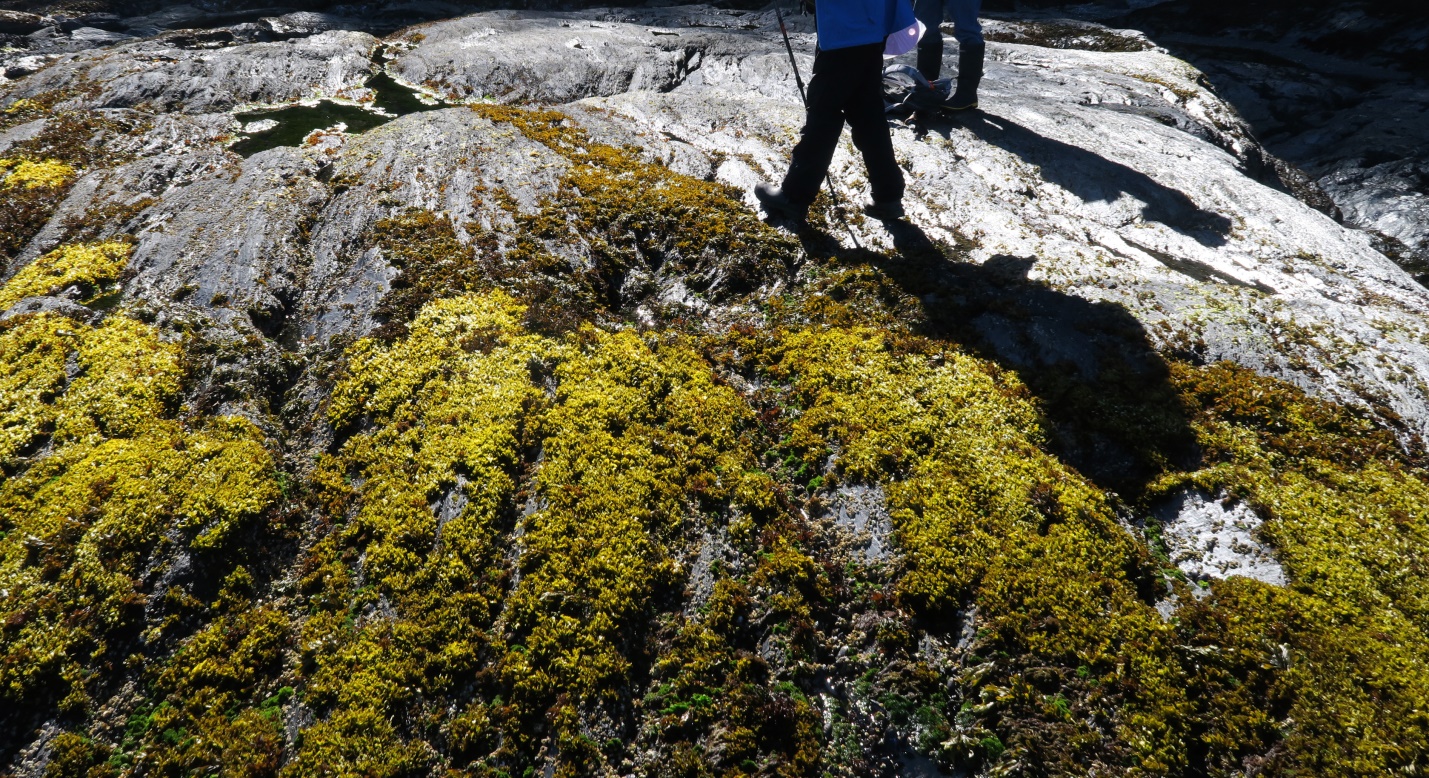
Figure 2: This seaweed, an often mainly yellow-colored “red”, grows in frilly turf formation as is seen here. In the background you will note Person 1 is standing quite far away (only boots and knees are visible), assiduously avoiding casting a shadow on the seaweed and the other Persons interacting with it. This seems to be a trait of this algae; it enjoys full exposure to the light and can be plentifully abundant in the surf swept exposed rocky locations it prefers. Mill Bay, Juan de Fuca Strait, B.C., Canada. June 6, 2023. Photo ID 27598 ©Seaweedwhisperings.com
Person 2:
“Wow! Look at them!” I recall, exclaiming “The sun is backlighting the Nail brush Seaweed and the Pelvetiopsis up there”; they’re saying “Look at us, we may be small but we’re beautiful in our way!”
Oh! Wait a minute, that’s not Pelvetiopsis; it’s Mazzaella parksii!!
Here it is..., a species we’ve often looked for, growing on the top of the rocks, in the high, high intertidal zone and neighboring with other “close-to-the-rock” loving species, Fucus distichus and Pelvitiopsis limitata.
In this setting and at this time of day it is an expanse of gold!!
Gleaming in its glory.
Thriving at the top of the rock.
You are a golden “red” [red algae]!
Are you trying to improve on red? Or does red fade to gold and you are making the most of that – celebrating the gold that will, for you Mazzaella, invariably follow red?
Seen from above this seaweed is a confusion of round-topped, slightly spoon shaped golden blades.
They are so plentiful here – growing so closely together and sharing this home in this wild coast setting, that you cannot see where one begins and the other ends.
There’s not much variation, though. They all succeed by doing pretty much the same thing.
And they seem very content in that, highly content with that, as a matter of fact!
High atop these rocks, Mazzaella parksii, you look out and across and see first each other, then do you, or indeed, CAN you look further?
Do you see out and view the ocean that splashes you with its life giving qualities?
I think you do NOT. You KNOW it will be there; you have absolute trust that IT will come to YOU. After all, it is in that manner that you reached your position here, your current success at the top of this rock.
As a group you are splendidly golden and gleaming.
You persist, and do so with such a display of plenty, thriving in an area where that success might seem to be very difficult or highly improbable to achieve.
You tolerate your neighboring species – but you don’t have much in common, and don’t even relate with them, no, not much at all. Cladophora, Fucus and Pelvetiopsis and a bit of Mastocarpus – they all do life SO differently. You respect them but you also are almost ‘surprised’ and even a touch ‘suspicious’ that it works for them – their differences seem that large, almost an aberration.
You’ll keep to the Mazzaella parksii way – in that you are totally confident and therefore abundance of success will be surely golden.
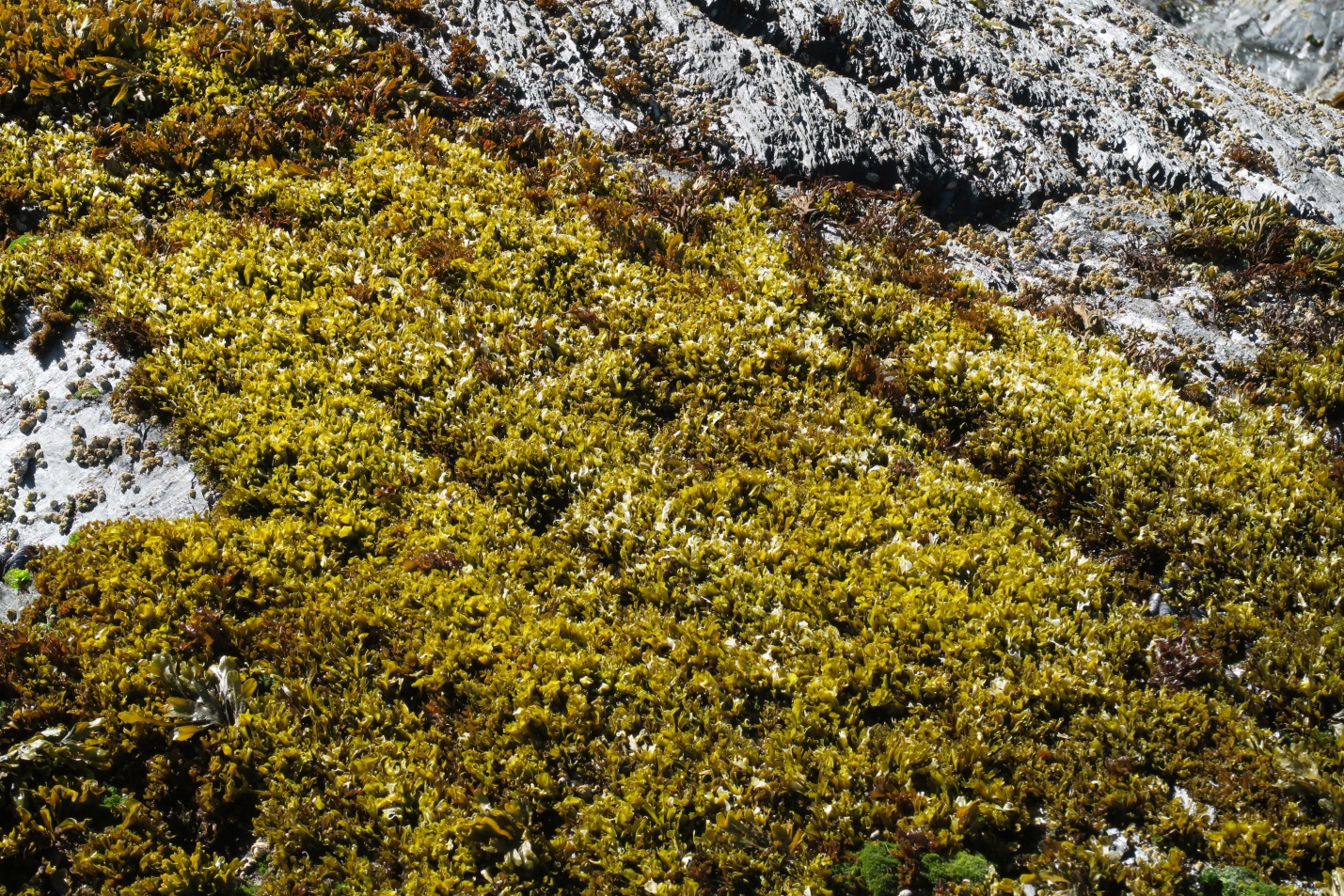
Figure 3: Frilly Turf Seaweed, indeed! Here the mass of golden-colored Iridescent Horn-of-Plenty is also, if you observe closely in numerous individuals, bleached to almost white at the curved tips. The area carpeted with this seaweed was 1.5 or 2.0 meters across; this is larger than what is commonly reported for this species suggesting that this site is a prime one for Mazzaella parksii. Mill Bay, Juan de Fuca Strait, B.C., Canada. June 6, 2023. Photo ID 27599 ©Seaweedwhisperings.com
Person 3:
Hiding in plain sight.
No need to draw attention to self, just there.
Happy amongst a diversity of others.
It seems to seek higher exposed areas.
Profuse once gets going.
Sometimes too much too quickly.
Why do you want to be with those different seaweeds – Cladophora columbiana, Fucus distichus, Microcladia borealis and Pelvetiopsis limitata? Those others have a certainty to them and this is attractive to Mazzaella parksii.
Does it need or just want the company of others of like mind, or ones who are compatible?
Can get going in a way of “too much too quickly”, then gets burnt if overdoes things?
That overdoing felt like a form of certainty in them.
Is their certainty annoying to others?
Not particularly ambitious with new ideas; content with what is known.
Small ambitions? No..., that’s not what I mean; it’s just almost not particularly creative.
Open?
Generous?
Do they at times feel that too much is taken from them?
I felt as though information was coming to me in bursts, so something was given then there was a hesitation and then it gave some more.
Will they impose? I couldn’t tell.
Perhaps they overwhelm.
On first starting this Whispering I originally felt quite content to sit with the seaweed and look around – Mazzaella parksii didn’t seem to demand much of me. However, I also noted that the longer I interacted with this seaweed the more uncertainty or level of confusion there was arising within me. It feels as if for this seaweed if I’d been willing to appreciate it and then just move on, it would have been most content.
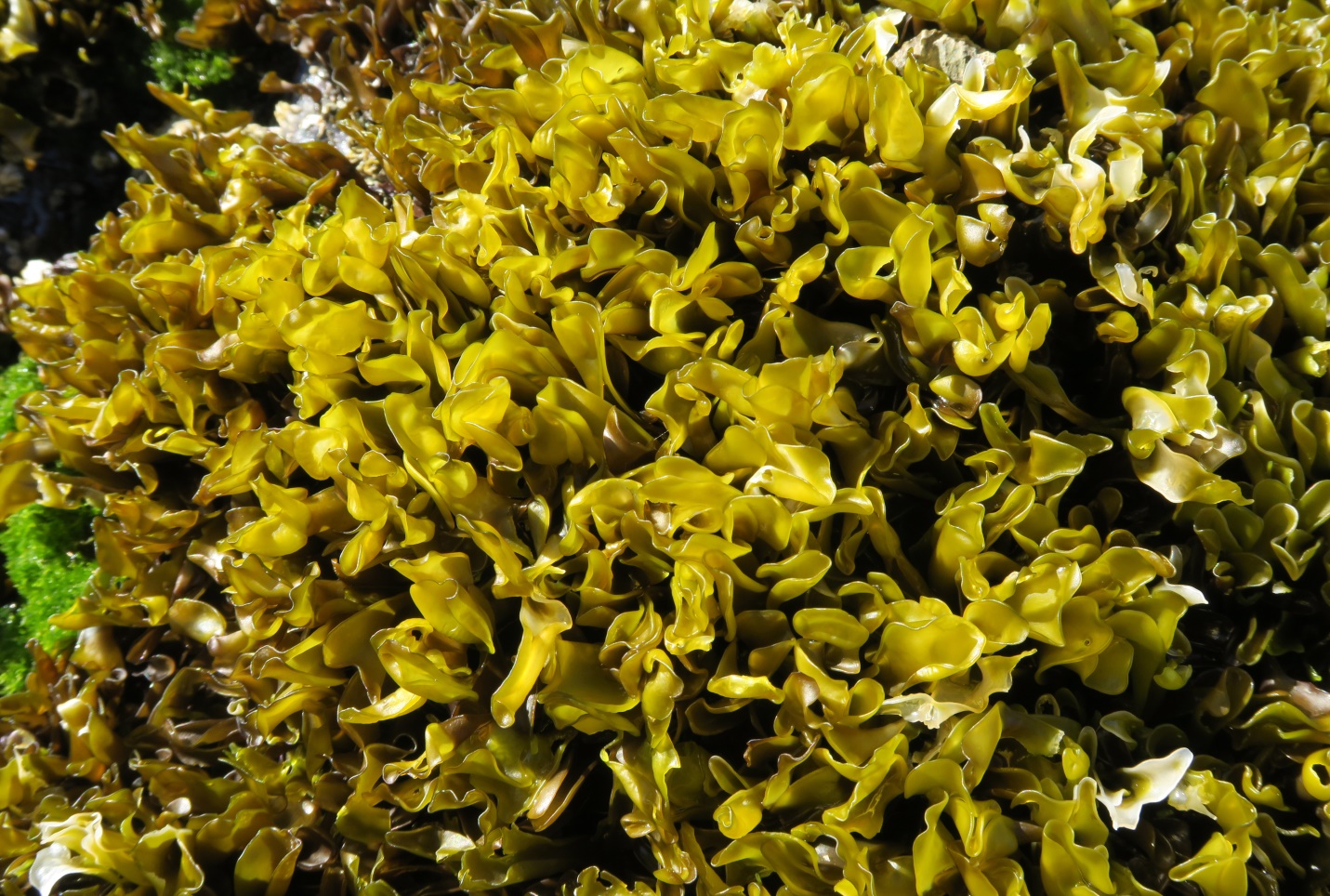
Figure 4: A view of one frilly cluster reveals the form of these distinctive algae. On the edges of the image, some blades are faded to nearly pure white. These have been fully bleached from their original purplish brownish red coloration. Bleaching from reddish to yellow green is “normal” for this species; bleaching all the way to white is indicative of damaged or dead tissue. Mill Bay, Juan de Fuca Strait, B.C., Canada. June 6, 2023. Photo ID 27600 ©Seaweedwhisperings.com
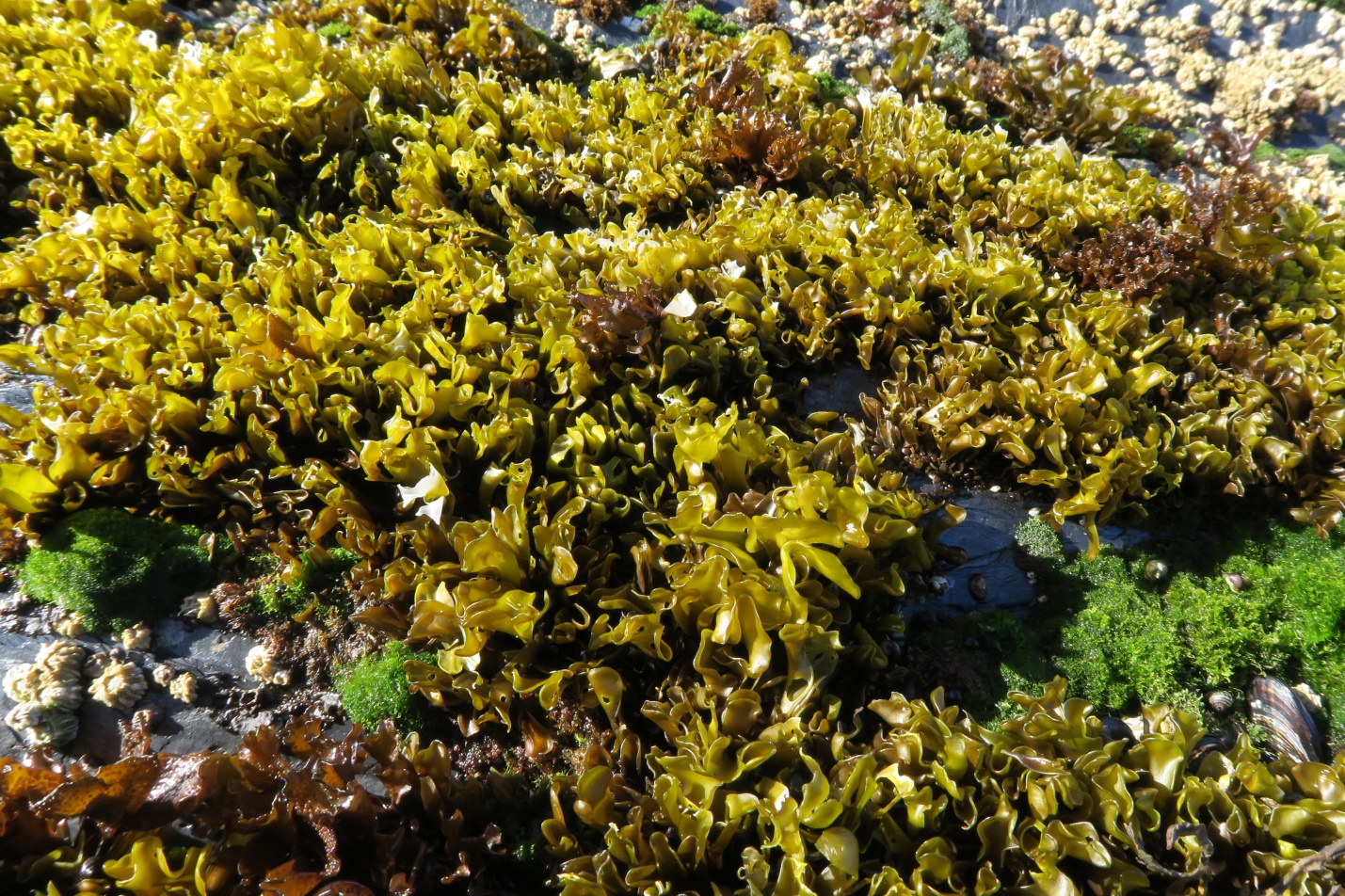
Figure 5: An expanse of varied macroalgae seen growing atop this surf swept rock. The “red” Mazzaella parksii is appearing mostly golden in this photo and the careful observer will note the reddish brown color of some of the lower sections of its blades. Mastocarpus sp. ads some true red color and a different texture to the display and Cladophora sp. adds the bright green highlights. Mill Bay, Juan de Fuca Strait, B.C., Canada. June 6, 2023. Photo ID 27601 ©Seaweedwhisperings.com
Discussion:
Profusion and confusion. There is certainty to the energy of this seaweed, and also tentativeness could be discerned. It feels as if they are certain in themselves, but may come across to the observer a little differently.
“Trust IT will come to YOU (the sea)...” Mazzaella parksii is SO certain in this. This is not quite the condition of being self-assured or overly confident – instead it seems as if it is an unexamined ‘expectation’. There WILL BE PLENTY, even in this high up above the tide place (where, in fact, it might not be rational to hold such expectations); that is simply how life is for them.
And in having that plenty, that abundance, that wealth of whatever they enjoy, they are also generous with it. They do enjoy themselves in the sharing it. It feels like this is who they love to be, it is a part of their innate identity – that they are ones who share their wealth, and of course in so doing, this reinforces the concept – there is plenty!
Mazzaella, by maintaining its state of plenty and also sharing it with others, can create some uncertainty in others; there can be some confusion about this profusion. At times it can actually be uncomfortable to be offered so much from them, to be on the receiving end of offers of “plenty”. Many others do not live a life of reliable and routine “plenty and abundance”, and strong exposure to this can exacerbate the contrasts.
And just what does M. parksii want in return..., recipients of their sharing of plenty might wonder? Do their gifts come with “no strings attached”?
It seems that what Mazzaella parksii wants is that you appreciate what they have to share. You don’t have to appreciate them as “the sharer”, but they do want your appreciation of WHAT they share. In a sense this is a tacit agreement, consensus with, acceptance and approval of their life choices and priorities. And, indeed, this is the chief area in which the Mazzaella type of energy can lose a touch of their confidence – that is if you do NOT share in that appreciation of ‘what’ they want to offer.
After all, this is the IRIDESCENT------HORN-of-PLENTY; so as the name suggests, there are shining offerings here, this is the idea, and they are not just shining, they are IRIDESCENT offerings, AND of course there is PLENTY, there is abundance. The common name says much, indeed, about the energy of this seaweed.
However this seaweed may be named, looking up close at the individual alga, iridescence was not obvious, except for the hint of it residing in the reddish base of the seaweed. However from a distance, what drew our attention to this seaweed was all about its “golden gleam”. In the early morning light, it caught the beams of the sun’s rays with luminosity.
From a distance, appreciating the “plenty” of this seaweed is instantaneous – it gleams with a lustrous radiance. Perhaps, that is the way they best like to be seen, too; close and individual scrutiny is NOT wanted.
In fact, upon close scrutiny on this day in early June, we found that parts of the blades of Mazzaella parksii were are sun “burned” or “bleached” – they were not flawless at all! And where they are bleached / burned is at their blade tips. This is the place where one individual might be a bit taller than the rest of the group. Where the group could not shade or hydrate them.
It seems that being much different than their group can be risky; that the conditions of where they live “prune” them back to size and demand conformity with their group. The result is there is “one way” that works for them, and when they embrace that way, well, that is when then they can be plentiful.
Is this vulnerability at the tips, or vulnerability when being different, or vulnerability when growing taller than its neighbor related to the noted speed, “getting going too quickly”..., or is it really about doing something different? It feels like they’re very slow to change their ways, so if they’re going to change their ways they need to consider it carefully and then they will only gradually change their ways. Typically they don’t just take on a new idea and go with it, or not very successfully anyway. There is a preference in them that it doesn’t appear that they’re suddenly doing something new, because that would imply there had been something wrong with what they’d previously been doing.
If enough of them get going really quickly and put on a growth spurt, it would likely be OK; they won’t get burnt back to size and there’d be a “taller” patch existing quite well as a group. But ironically, it seems they would only get to employing speedy growth as a ‘new’ life option via a very slow process of consideration and evaluation.
“Perhaps they overwhelm” was a concept that arose in our interactions, and it does feel that with Mazzaella’s strong confidence in their manner of being, in their mode of maintaining a predictable type of success, in the gleaming appeal of their abundance and plenty..., well, to those with other priorities or interests, but who also are a bit more uncertain and who possibly have a weaker will, these others could quite easily be overwhelmed and even ‘subsumed’ into the Mazzaella way of life. Indeed some others may anticipate this outcome if they were to associate too closely with M. Parksii and so they intuitively keep their distance, indeed, to save themselves from being taken in and encompassed of subsumed by the Mazzaella influence.
Person 1 noted early on a disinterest in “getting to know it physically” and had the clear preference to watch or interact from a distance, AND also to take care to NOT cast his shadow on this seaweed. Not casting a shadow seems to reflect how the Mazzaella type does not tolerate criticism or dissent, or in other words, how it needs to have a ‘radiant’ reputation. Person 3 noted a response to the energy of this seaweed which also indicated it was best to keep interactions “short and sweet”. Initial impressions from Mazzaella parksii were clearly and quite immediately received; but longer interaction seemed to lead a quite different set of impressions, creating an aspect of confusion and what can feel almost always like a diminishment of that initial impression. The sense was, once again, if one is willing to appreciate its energy and just move on, this seaweed is definitely happiest with that. Long duration of, or physically close interaction, is something that is NOT its preference.
So, we come back to that first ‘picture’, what first caught our attention on the day of our Whispering..., the gleaming cap of golden-colored seaweed atop its wild wave-swept rock that was truly radiant in the day’s first light – THAT is what Mazzaella parksii loves others to take note of and to recognize in them – precisely and only that.
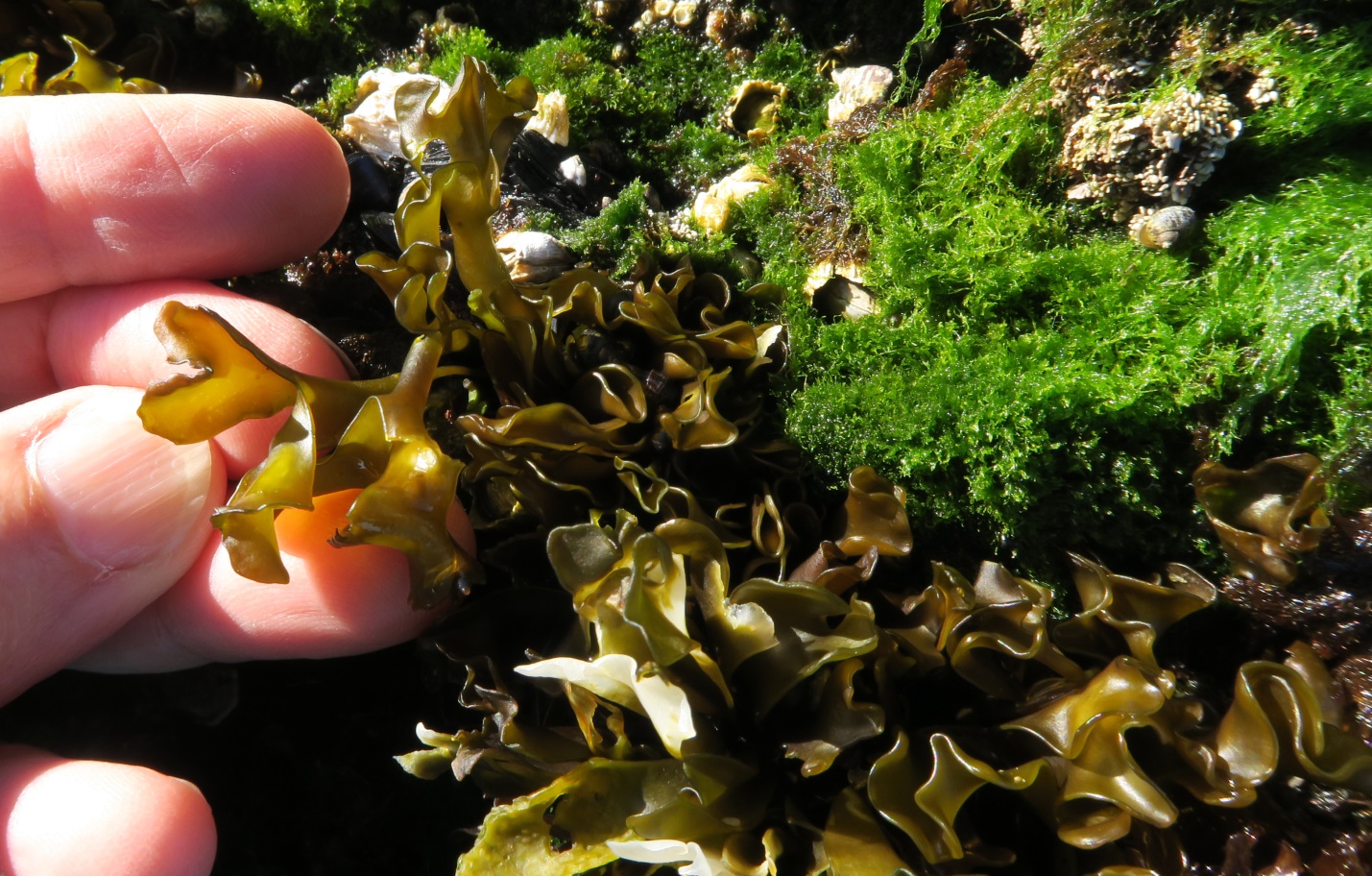
Figure 6: A species in our area that is typically at its prime in late April or early May, seen here in early June is showing signs of long life including sun and grazing damage. The two thalli “in hand” are separated out to show their cleft lobes and curled growth habit. If you look deeply down into the “spoons” formed by the blades you will find a hint of the purplish-red-brown that tells us this truly a “red” alga. Mill Bay, Juan de Fuca Strait, B.C., Canada. June 6, 2023. Photo ID 27602 ©Seaweedwhisperings.com
Biology & Natural History Information:
Description:
Thallus is brownish-red-purple to olive brown or yellowish-green blade, averaging 3 – 5 cm (1 – 2 in) tall, thick, rubbery, spatulate, and shallowly cleft variously into one to three rounded lobes. Blades that do not separate into lobes do curl inward and have been likened to “tiny Chinese soup spoons”; this description not only characterizes the shape but brings to mind also the firm texture of the individual blades of this alga. Blades arise from a perennial encrusting base, and are densely packed into frilly looking groupings or turfs atop surf swept rocks. Some authors indicate patches may grow up to 40 cm across. At maturity the blades may be textured by very large bulging bumps – these are reproductive cells named cystocarps and are plainly visible to the naked eye.
Habitat:
This species forms dense clusters or carpets on surf-exposed rock in the high intertidal of semi-exposed and exposed coastlines.
North Pacific Distribution:
Aleutian Islands, Alaska to Mendocino County, California; Russia and Japan.
Remarks:
The male Mastocarpus alaskensis has a similar shape and color but is slightly more cartilaginous than Mazzaella parksii. And while Mastocarpus grows from a perennial crust in clusters, it rarely forms such tight carpets as Iridescent Horn-of-Plenty. Apart from species confusion in identifying this seaweed in the wild, one other feature that can be confusing is that this is a “red” alga that rarely looks very red. The visible portions of this seaweed are often bleached yellow-green in color but if you look closely at their bases, you will see the wine red or purplish brown-y red of their true clade.
The genus Mazzaella is named for Angelo Mazza, an Italian phycologist. As a group, they are often called “Rainbow Leaf” which calls to mind the iridescence of many recognizable species.
Classification:
Phylum: Rhodophyta
Class: Florideophyceae
Order: Gigartinales
Family: Gigartinaceae
Genus: Mazzaella
Species: Mazzaella parksii (Setchell & N.L.Gardner) Hughey, P.C.Silva & Hommersand 2001
Former name(s): Iridophycus parksii; Iridaea parksii; Irideae laminarioides var. cornucopiae; Mazzaella cornucopiae.
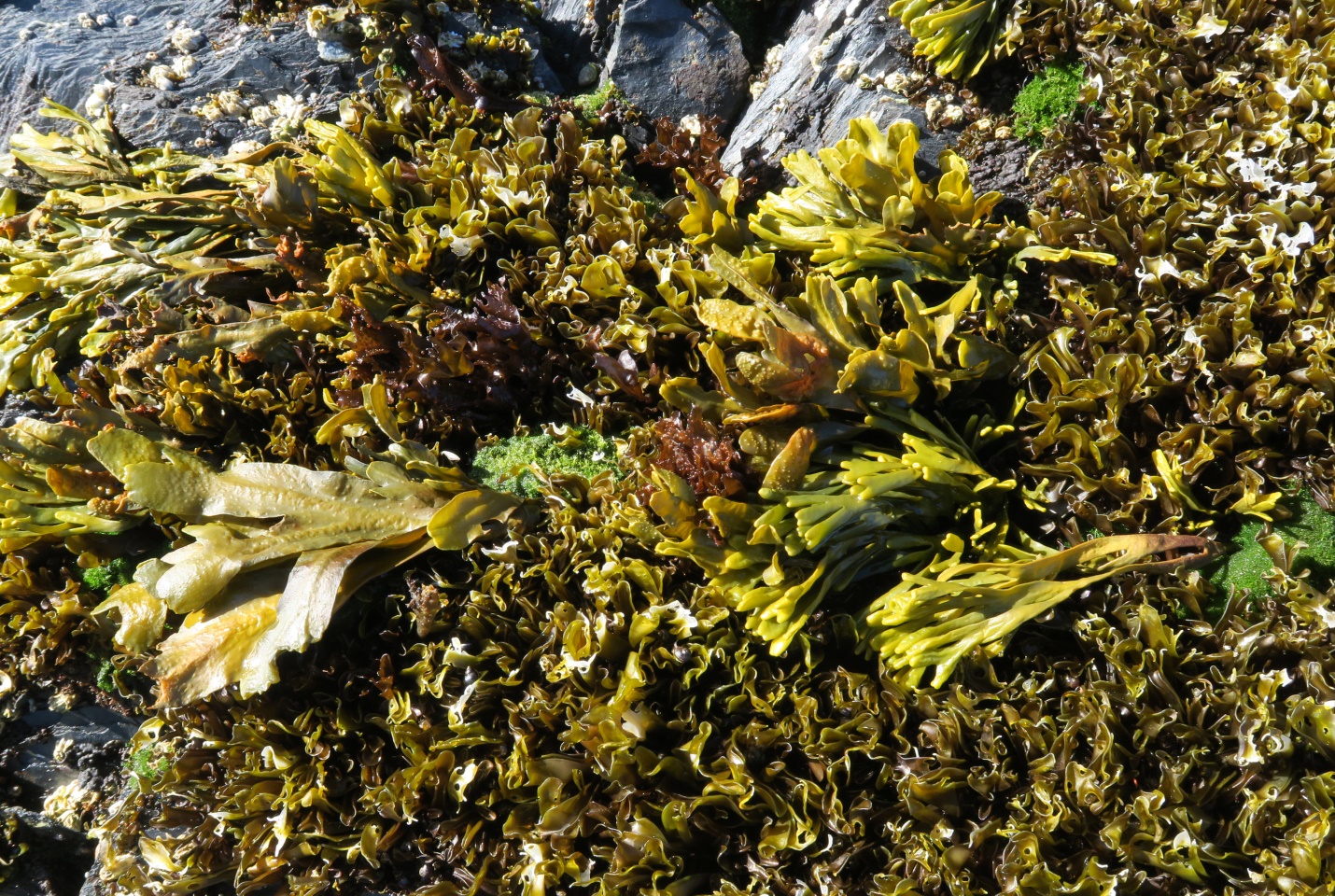
Figure 7: This photograph is down from the crest of the rock just a bit and it is in an area where a few crevices hold a bit of water and where a greater variety of seaweeds can live. In this image we have present Fucus distichus, Mastocarpus spp., Cladophora columbiana and Pelvetiopsis linearis. The lower growing carpet, the purplish brown to olive green frilly mass of seaweed, is our species of interest – Mazzaella parksii. Mill Bay, Juan de Fuca Strait, B.C., Canada. June 6, 2023. Photo ID 27603 ©Seaweedwhisperings.com
![]()